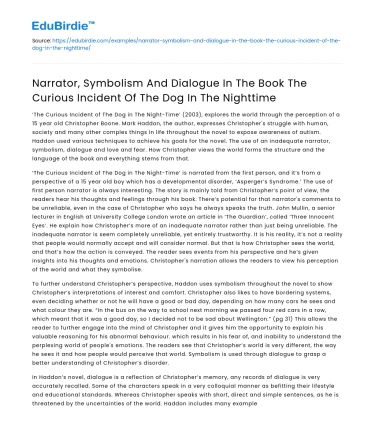‘The Curious Incident of The Dog in The Night-Time’ (2003), explores the world through the perception of a 15 year old Christopher Boone. Mark Haddon, the author, expresses Christopher's struggle with human, society and many other complex things in life throughout the novel to expose awareness of autism. Haddon used various techniques to achieve his goals for the novel. The use of an inadequate narrator, symbolism, dialogue and love and fear. How Christopher views the world forms the structure and the language of the book and everything stems from that.
‘The Curious Incident of The Dog in The Night-Time’ is narrated from the first person, and it’s from a perspective of a 15 year old boy which has a developmental disorder, ‘Asperger’s Syndrome.’ The use of first person narrator is always interesting. The story is mainly told from Christopher’s point of view, the readers hear his thoughts and feelings through his book. There’s potential for that narrator's comments to be unreliable, even in the case of Christopher who says he always speaks the truth. John Mullin, a senior lecturer in English at University College London wrote an article in ‘The Guardian’, called ‘Three Innocent Eyes’. He explain how Christopher’s more of an inadequate narrator rather than just being unreliable. The inadequate narrator is seem completely unreliable, yet entirely trustworthy. It is his reality, it’s not a reality that people would normally accept and will consider normal. But that is how Christopher sees the world, and that’s how the action is conveyed. The reader sees events from his perspective and he’s given insights into his thoughts and emotions. Christopher's narration allows the readers to view his perception of the world and what they symbolise.
Save your time!
We can take care of your essay
- Proper editing and formatting
- Free revision, title page, and bibliography
- Flexible prices and money-back guarantee
To further understand Christopher’s perspective, Haddon uses symbolism throughout the novel to show Christopher’s interpretations of interest and comfort. Christopher also likes to have bordering systems, even deciding whether or not he will have a good or bad day, depending on how many cars he sees and what colour they are. “In the bus on the way to school next morning we passed four red cars in a row, which meant that it was a good day, so I decided not to be sad about Wellington.” (pg 31) This allows the reader to further engage into the mind of Christopher and it gives him the opportunity to explain his valuable reasoning for his abnormal behaviour. which results in his fear of, and inability to understand the perplexing world of people's emotions. The readers see that Christopher’s world is very different, the way he sees it and how people would perceive that world. Symbolism is used through dialogue to grasp a better understanding of Christopher’s disorder.
In Haddon’s novel, dialogue is a reflection of Christopher’s memory, any records of dialogue is very accurately recalled. Some of the characters speak in a very colloquial manner as befitting their lifestyle and educational standards. Whereas Christopher speaks with short, direct and simple sentences, as he is threatened by the uncertainties of the world. Haddon includes many examples of Christopher’s efforts to understand the world. For example, “I got Siobhan to draw lots of these faces and then write down next to them exactly what they meant” (pg 3). Christopher’s autism carries many burdens therefore it can be very challenging for him to communicate with others. He tries to understand human emotions but is unable to do so, the emotions and ambiguity contained in language challenge Christopher. Characters in the novel are also unable to communicate effectively causing misconception between each relationship. The use of dialogue highlights Christopher’s love and fear of the world.
The use of love and fear for the novel allows the reader to develop a deeper understanding of the condition of Christopher’s symptom. Love and fear through Christopher’s perspective is different. Due to his condition, Christopher likes set rules about what he and others are allowed to do. He like facts and subjects such as maths, science which had right and wrong answers. For example, “I had to get out of the house. Father had murdered Wellington. That meant he could murder me, because I couldn’t trust him, even though he had said. ‘Trust me’, because he had told a lie about a big thing.” (pg 152) This passage is about father admitting to Christopher that he had murdered Wellington. Even though his dad said “trust me,” Christopher does not like lying and especially the fact that his father had lied to him. He felt deceived and hoaxed dispatches represents love and fear because his father loves him but is scared that he may lose him after this. Love and fear are both explored throughout the novel, to expose Christopher’s perspective of the world.
In Mark Haddon’s contemporary novel ‘The Curious Incident of The Dog in The Night-Time’ successfully explore the awareness of the autism spectrum. Haddon has exposed the perspective of a child with ‘Asperger's syndrome’ through characterisation. Haddon exemplifies through the use of an inadequate narrator, symbolism, dialogue and love and fear. The use of language in the story allows the reader to develop a deeper understanding of the conditions of autism illness.






 Stuck on your essay?
Stuck on your essay?

